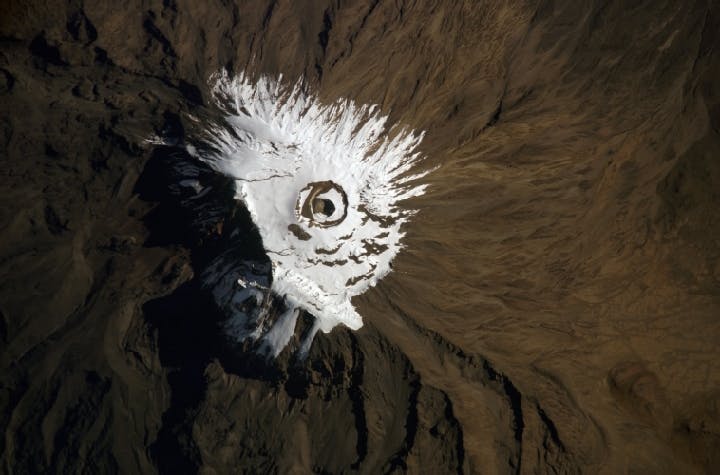Winter 2008
What’s Actually Happening to the Snows of Kilimanjaro?
– The Wilson Quarterly
The shrinking glacier on Tanzania's Mount Kilimanjaro are, for many, including Al Gore, a prime example of global warming. But scientific study shows the truth is much more complex.
Startling before-and-after images of the retreating glacier on Tanzania’s Mount Kilimanjaro in An Inconvenient Truth—the 2006 documentary that helped Al Gore win a share of the Nobel Peace Prize—bear seemingly convincing witness to the growing perils of global warming. As in so many instances in the global climate debate, however, the reasons why Kilimanjaro’s 11,000-year-old glacier is dwindling are complex, and “bear only indirect connections, if any,” to global warming, according to Philip W. Mote and Georg Kaser.
Tropical glaciers, such as the one on Kilimanjaro’s Kibo Peak (19,340 feet) or the Quelccaya ice cap in the Andes (18,600 feet), occur when mountain summits penetrate the subzero air of the upper troposphere. Snow precipitation helps them grow; melting, usually as the result of solar radiation and light wind, and sublimation (ice converting instantly to water vapor due to dryness in the atmosphere) makes them retreat.
As Mote, a researcher at the University of Washington, and Kaser, a glaciologist at the University of Innsbruck in Austria, point out, a rise in the global temperature “fails spectacularly” to explain the disappearance of Kilimanjaro’s glacier, since the air temperature at the site almost never goes above freezing. (This is not the case with the world’s receding nontropical glaciers, and global warming “appears to be the primary culprit” in their decline.)
Observers have been tracking the shrinkage of Kilimanjaro’s glacier ever since Europeans first scaled the peak in the 1880s, but the ice cap at that time may have been unusually large following several decades of above-normal precipitation. Judging from nearby Lake Victoria’s water level, the climate in the region has gotten progressively drier since the Victorian era. Global warming may have contributed to the pattern in recent years, but that would only account for “at most a fraction of the recent decline in ice,” say the authors.
Kaser, a longtime student of tropical glaciers who journeyed to Kilimanjaro in 2001, says diminished snowfall has allowed solar radiation and other forces to whittle away the glacier’s edges, creating steep walls. As a result, the glacier also retains less of each year’s snowfall than it did in the past. In effect, the glacier is being starved of ice.
Ironically, the authors say, “substantial global warming accompanied by an increase in precipitation might be one way to save Kilimanjaro’s ice.” If temperatures near the summit rose enough to encourage melting, gentler slopes might form, allowing snow to build up. An onslaught of snow might help too. The glacier could vanish, but if it does, global warming won’t be to blame.
* * *
The Source: “The Shrinking Glaciers of Kilimanjaro: Can Global Warming Be Blamed?” by Philip W. Mote and Georg Kaser, in American Scientist, July–Aug. 2007.
Photo courtesy of NASA
